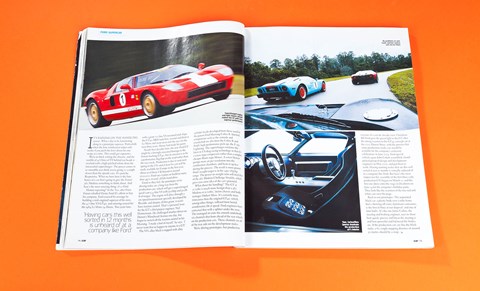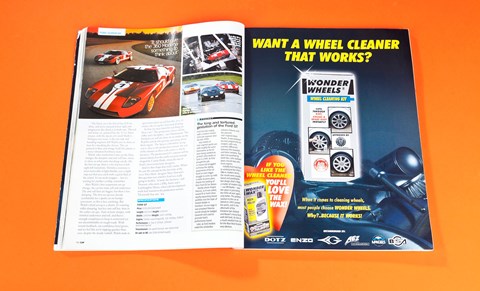Ford is muscling into Modena territory with the gorgeous GT supercar, being readied for launch in 2004. We drive the prototypes…
It’s raining on the handling course. What a day to be hammering along in a prototype supercar. Particularly when the lone windscreen wiper only works if you push the lever down for one swipe at a time. This could get expensive.
We’re in third, exiting the chicane, and the rumble of 4.6 litres of V8 behind our heads is overlaid with a high-pitched whine from the intercooled supercharger. The power comes in so smoothly you think you’re going 10-20mph slower than the speedo says. It’s punchy. Responsive. What we have here is the bare bones of a car that’s going to give the Ferrari 360 Modena something to think about. And here’s the most amazing thing: it’s a Ford.
History repeating? In the ’60s, after Enzo Ferrari rebuffed Henry Ford II’s efforts to buy his company, Ford exacted his revenge by building a mid-engined supercar of his own, the 4.7-litre V8 GT40, and entering several for the 1964 Le Mans 24 Hours. Two years later, with a giant 7.0-litre V8 mounted mid-ships, the GT40 MkII took first, second and third at Le Mans and went on to win the race for the next three years. Henry had made his point.
Nearly four decades later, the new Ford GT might be a lovingly executed homage to the Ferrari-bashing GT40, but its mission is to be a performance flagship on the road rather than the race track. Production is due to start next spring in the US, and at least 8o cars will be made available for Europe in the first year, about 15 of them UK-bound at around £100,000. Ford says it plans to build no more than 4500 in total, all left-hand drive.
Good as they feel, the prototypes we’re driving today are a long way from the production cars, which will get a supercharged quad-cam 5.4-litre V8 with 500bhp and 500lb ft of torque. The engine will drive through a six-speed transmission specially developed by Ricardo, and despite all that grunt, it won’t have traction control. That’s a personal issue for the GT’s chief project engineer, Neil Hannemann. He challenged another driver on Detroit’s Woodward Avenue one day, but forgot to switch off the traction control in his Mustang. ‘I made a fool of myself,’ he says. ‘I never want that to happen to anyone in a GT.’
The V8’s alloy block is topped with alloy cylinder heads developed from those used in the potent Ford Mustang Cobra R. Internal components such as the conrods and cranskshaft are also from the Cobra R and Ford’s high-performance pick-up, the F-150 Lightning. The supercharger emulates the latest in US drag racing technology in that it’s a screw-type compressor rather than a simpler, cheaper Roots-type blower. A screw blower pumps more air per revolution into the combustion chambers, and heats it up less during the process. The result is more power. Ford’s weight target is in the 1450-1650kg range. The power-to-weight ratio will rival that of the 360 Modena Challenge Stradale, which gives you some idea of the car’s potential.
What about the handling? The GT at 11/10ths is much more benign than a 360 Modena at 11/10ths,’ insists chassis and body manager Hubert Mees. It’s certainly more innocuous than the original GT40, which, among other things, suffered from horrid aerodynamic lift at speed. Ford engineers have corrected that with a splitter under the nose. The managed air exits the smooth underbody via channels that form ahead of the rear wheels on the production cars. These channels are aft of the rear axle on the development mules.

We’re driving prototypes, but production versions of a sort do already exist. Chairman Bill Ford gave the green light to the GT after the strong reaction to the GT40 concept car at the 2002 Detroit Show, with the proviso that some production-ready cars would be available for the company’s centenary celebrations in June 2003. Ford special vehicles guru John Coletti assembled a hand-picked group of design and development engineers in May 2002, and put them to work.
Having running mules that are this well sorted in just 12 months is virtually unheard of in a company like Ford. But here’s the most impressive bit: assembly of the first three early production GTs began on March 10, and the first one drove onto the stage in Dearborn on June 14 for the company’s birthday party. They look like the rearmost of the two red and white cars over the page.
Back to our prototypes. The unpainted black car, a plastic body over a tube frame that’s showing off some aluminum extrusions, is the first of three at our disposal (and one of nine built). It’s the one Jamie Cullen, the steering and braking engineer, uses to show how quick, precise and linear the steering is and how powerful and balanced the brakes are. If the production cars are like the black mule, a 60-0mph stopping distance of around 30 metres should be a snap.
The black car is the first of two GTs we drive, and we’re amazed at how light and progressive the clutch is in both cars. The red and white car, painted like the ’67 Le Mans winner, with the decals of Carroll Shelby’s Terlingua race team, is the one ride and handling engineer Jeff Walsh uses to show us how he’s tweaking the chassis. The car painted in blue and orange Gulf Oil colours is a noise/vibration/harshness mule.
Walsh, who worked for Lotus on the Elise, changes the dampers and anti-roll bars, twice, to show us what some tweaking can do. On the first set-up, there’s a bit of pivot in left-right-left transitions. Harmless oversteer is most noticeable at light throttle, just a slight step-out that you catch with a quick flick of the wheel. It’s no neck-snapper — but it’s waiting for another 100bhp, remember.
After Walsh’s first suspension set-up change, the car has more roll and understeer. The anti-roll bars are bigger, but there’s less damping. The first set-up was already comfortable for a sports car on bumpy pavement, so this is less satisfying. But Walsh’s third set-up is a charm. It’s running stiffer damping, but less anti-roll bar, than in the earlier set-ups. Turn-in feels sharper, with minimal understeer and roll, and there’s enough compliance to keep it connected yet not uncomfortable on rough roads. With instant feedback, our confidence level grows, and we feel like we’re lapping quicker than ever, despite the steady rainfall. Walsh nods in agreement when we tell him this. It is, of course, the set-up he’s favoured all along.
So how far away from the real thing are these cars? ‘The production chassis will be stiffer and a lot lighter,’ says Hannemann. The finished cars will also have an air intake on the B-pillar and double glazing separating driver from engine. The Sparco carbonfibre racing seat is close to the production version; the rest of the interior on these early mules is strictly business. The production GT’s exterior will be almost identical to the coolly reverent concept shaped by Camilo Pardo, ironically one of Ford’s most iconoclastic designers.
And it’s that shape that really counts. When he saw the concept for the first time at the 2002 Paris Show, designer Marc Newson’s first question was whether Ford was really going to build it. ‘It looks the business,’ said Newson, who owns a DB4 Aston and a Lamborghini Miura, when told development work had started on the production version. ‘I’d actually buy one.’
Read more CAR archive content
